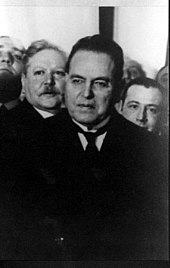
1916 Argentine general election

|
| |||||||||||||||||||||||||||||||||||||||||||
Presidential election | |||||||||||||||||||||||||||||||||||||||||||
| |||||||||||||||||||||||||||||||||||||||||||
300 members of the Electoral College 151 votes needed to win | |||||||||||||||||||||||||||||||||||||||||||
|---|---|---|---|---|---|---|---|---|---|---|---|---|---|---|---|---|---|---|---|---|---|---|---|---|---|---|---|---|---|---|---|---|---|---|---|---|---|---|---|---|---|---|---|
| |||||||||||||||||||||||||||||||||||||||||||
 Most voted party by province. | |||||||||||||||||||||||||||||||||||||||||||
| |||||||||||||||||||||||||||||||||||||||||||
| |||||||||||||||||||||||||||||||||||||||||||
62 of 120 seats in the Chamber of Deputies | |||||||||||||||||||||||||||||||||||||||||||
| Turnout | 65.59% | ||||||||||||||||||||||||||||||||||||||||||
This lists parties that won seats. See the complete results below.
| |||||||||||||||||||||||||||||||||||||||||||
General elections were held in Argentina on 2 April 1916. Voters elected the President, legislators, and local officials. The first secret-ballot presidential elections in the nation's history, they were mandatory and had a turnout of 62.8%. The turnout for the Chamber of Deputies election was 65.9%.

Background

President Roque Sáenz Peña kept his word to the exiled leader of the Radical Civic Union (UCR), Hipólito Yrigoyen, who in turn abandoned his party's twenty-year-old boycott of elections. The president overcame nearly two years of conservative opposition in Congress (and pressure from his own social class) to pass in 1912 what was later known as the Sáenz Peña Law, which mandated universal male suffrage and the secret ballot. His health deteriorating quickly, the President lived to see the fruition of his reforms: the 1914 mid-term elections, which gave the UCR 19 out of the 60 Lower House seats in play (the ruling party obtained 10) and the governorship of Santa Fe Province (then the second-most important). Another beneficiary of the Sáenz Peña Law was the Socialist Party, led by Congressman Juan B. Justo. The formerly dominant PAN remained divided between the Conservative Party, led by the Governor of Buenos Aires Province, Marcelino Ugarte, and the Democratic Progressive Party, led by a reformist publisher and Congressman, Lisandro de la Torre.[1]

Strengthened by both popular appeal and the fractiousness of its opposition, the UCR experienced dissent within from its Santa Fe Province chapter, whose endorsement Yrigoyen was unable to obtain. The Socialists lost one of its best-known lawmakers, Alfredo Palacios, who would run on a splinter Socialist ticket for several future elections. The Conservative Party's presumptive nominee, Governor Ugarte, stepped aside in favor of a lesser-known party figure, San Juan Province Governor Ángel Rojas, in a bid to attract votes from the hinterland and from moderates. President Victorino de la Plaza refused to interfere on behalf of the Conservatives (despite an assassination attempt that would have provided him with ample pretext). Refusing to back them, he fielded his own Provincial Party, which was limited mainly to his native Santiago del Estero Province. Faced with only token opposition from the remnants of the once-paramount PAN, Yrigoyen pledged to donate his salary to charity, if elected, and encouraged the rich country's impoverished majority to know him as "the father of the poor". [2]

Election day, April 2, handed an unexpectedly large victory to Yrigoyen, who still had to await the results from the electoral college (which met in July). The dissident Santa Fe UCR had drained a significant number of electors from the official ticket, and Yrigoyen obtained but 133 of the body's 300 electors. Numerous Democratic Progressives, moreover, became faithless electors - pledging their support to the Conservative Party. Santa Fe's UCR, however, resorted to the same tactic, allowing Yrigoyen its 19 electors and making the patient activist for voter rights the first democratically elected President of Argentina.[3]

Candidates
- Radical Civic Union (populist): President of the UCR Hipólito Yrigoyen of the city of Buenos Aires
- Conservative Party (conservative): Governor Ángel Rojas of San Juan Province
- Democratic Progressive Party (reformist): Deputy Lisandro de la Torre of Santa Fe Province
- Socialist Party: Deputy Juan B. Justo of the city of Buenos Aires
-
Yrigoyen
-
Rojas
-
de la Torre
-
Justo
President
Popular Vote
| Presidential candidate |
Vice Presidential candidate |
Party | Popular vote | Electoral vote | |||
|---|---|---|---|---|---|---|---|
| Votes | % | Votes | % | ||||
| Hipólito Yrigoyen | Pelagio Luna | Radical Civic Union (UCR) | 340.802 | 47,25 | 133 | 44,33 | |
| Ángel Dolores Rojas | Juan Eugenio Serú | Total Rojas-Serú | 150,245 | 20.83 | 70 | 23.33 | |
| Conservative Party | 96,103 | 13.33 | 46 | 15.33 | |||
| Popular Party | 16,141 | 2.24 | 7 | 2.33 | |||
| Democratic Union | 13,921 | 1.93 | 4 | 1.33 | |||
| Autonomist Party of Corrientes | 9,645 | 1.34 | |||||
| Civic Concentration | 9,170 | 1.27 | 7 | 2.33 | |||
| Provincial Party | 5,265 | 0.73 | 6 | 2.00 | |||
| Lisandro de la Torre | Alejandro Carbó | Total de la Torre - Carbó | 135,308 | 18.76 | 64 | 21.33 | |
| Democratic Progressive Party (PDP) | 115,604 | 16.03 | 49 | 16.33 | |||
| Provincial Union | 10,909 | 1.51 | 8 | 2.67 | |||
| Catamarca Concentration | 8,795 | 1.22 | 7 | 2.33 | |||
| Juan B. Justo | Nicolás Repetto | Socialist Party (PS) | 66.397 | 9,21 | 14 | 4,67 | |
| No candidates | Dissident Radical Civic Union | 28.116 | 3,90 | 19 | 6,33 | ||
| Argentine Socialist Party (PSA) | 347 | 0,05 | |||||
| Total | 721.215 | 100 | |||||
| Positive votes | 721.215 | 96,49 | |||||
| Blank votes | 26.256 | 3,51 | |||||
| Total votes | 747.471 | 100 | |||||
| Registered voters/turnout | 1.189.254 | 62,85 | |||||
| Sources:[4][5][6][7] | |||||||
Electoral Vote
| Presidential Candidates | Party | Electoral Votes | |
|---|---|---|---|
| Hipólito Yrigoyen | Radical Civic Union | 152 | |
| Ángel Dolores Rojas | Conservative Party | 104 | |
| Lisandro de la Torre | Democratic Progressive Party | 20 | |
| Juan B. Justo | Socialist Party | 14 | |
| Alejandro Carbó | Democratic Progressive Party | 8 | |
| Total voters | 298 | ||
| Did not vote | 2 | ||
| Total | 300 | ||
| Vice Presidential Candidates | Party | Electoral Votes | |
|---|---|---|---|
| Pelagio Luna | Radical Civic Union | 152 | |
| Juan Eugenio Serú | Conservative Party | 103 | |
| Alejandro Carbó | Democratic Progressive Party | 20 | |
| Nicolás Repetto | Socialist Party | 14 | |
| Carlos Ibarguren | Democratic Progressive Party | 8 | |
| Julio Argentino Pascual Roca | Conservative Party | 1 | |
| Total voters | 298 | ||
| Did not vote | 2 | ||
| Total | 300 | ||
Electoral Vote by Province
| Province | President | Vice President | ||||||||||
|---|---|---|---|---|---|---|---|---|---|---|---|---|
| Yrigoyen | Rojas | de la Torre | Justo | Carbó | Luna | Serú | Carbó | Repetto | Ibarguren | Roca | ||
| Buenos Aires City | 30 | 14 | 30 | 14 | ||||||||
| Buenos Aires | 20 | 40 | 20 | 40 | ||||||||
| Catamarca | 3 | 7 | 3 | 7 | ||||||||
| Córdoba | 18 | 7 | 18 | 7 | ||||||||
| Corrientes | 6 | 12 | 6 | 12 | ||||||||
| Entre Ríos | 15 | 7 | 15 | 7 | ||||||||
| Jujuy | 2 | 6 | 2 | 6 | ||||||||
| La Rioja | 2 | 6 | 2 | 6 | ||||||||
| Mendoza | 8 | 4 | 8 | 3 | 1 | |||||||
| Salta | 4 | 8 | 4 | 8 | ||||||||
| San Juan | 3 | 7 | 3 | 7 | ||||||||
| San Luis | 3 | 7 | 3 | 7 | ||||||||
| Santa Fe | 19 | 8 | 19 | 8 | ||||||||
| Santiago del Estero | 10 | 4 | 10 | 4 | ||||||||
| Tucumán | 12 | 6 | 12 | 6 | ||||||||
| Total | 152 | 104 | 20 | 14 | 8 | 152 | 103 | 20 | 14 | 8 | 1 | |
| Sources:[8][9] | ||||||||||||
Chamber of Deputies
| Party | Votes | % | Seats won | Total seats | |
|---|---|---|---|---|---|
| Radical Civic Union (UCR) | 339,771 | 45.08 | 26 | 47 | |
| Total Conservative Parties | 165,729 | 21.99 | 18 | 43 | |
| Conservative Party | 112,922 | 14.98 | 15 | — | |
| Popular Party | 16,394 | 2.17 | — | — | |
| Democratic Union | 15,141 | 2.01 | 1 | — | |
| Provincial Union | 11,339 | 1.50 | 2 | — | |
| Autonomist Party of Corrientes | 9,933 | 1.32 | — | — | |
| Democratic Progressive Party (PDP) | 110,238 | 14.62 | 7 | 9 | |
| Socialist Party (PS) | 56,204 | 7.46 | 3 | 9 | |
| Dissident Radical Civic Union | 29,542 | 3.92 | 4 | 4 | |
| Liberal Party of Corrientes | 17,910 | 2.38 | 3 | 6 | |
| Others | 34,390 | 4.56 | — | 1 | |
| Vacant seats | 1 | 1 | |||
| Total | 753,784 | 100 | 62 | 120 | |
| Positive votes | 753,784 | 96.63 | |||
| Blank votes | 26,250 | 3.37 | |||
| Total votes | 780,034 | 100 | |||
| Registered voters/turnout | 1,189,254 | 65.59 | |||
| Sources:[10][11] | |||||
References
- ^ Todo Argentina: Roque Sáenz Peña (in Spanish)
- ^ Nouzeilles, Gabriella and Motaldo, Graciela. The Argentina Reader. Duke University Press, 2002.
- ^ Todo Argentina: 1916 Archived 2018-07-17 at the Wayback Machine (in Spanish)
- ^ Cantón, Darío (1968). Materiales para el estudio de la sociología política en la Argentina (PDF). Vol. Tomo I. Buenos Aires: Centro de Investigaciones Sociales - Torcuato di Tella Institute. p. 91.
- ^ Historia Electoral Argentina (1912-2007) (PDF). Ministry of Interior - Subsecretaría de Asuntos Políticos y Electorales. December 2008. Archived from the original (PDF) on 8 September 2014.
- ^ Las Fuerzas Armadas restituyen el imperio de la soberanía popular: Las elecciones generales de 1946 (PDF). Vol. Tomo I. Buenos Aires: Imprenta de la Cámara de Diputados. 1946. pp. 368–375.
- ^ Ansaldi, Waldo (Feb 1989). "Estado, partidos y sociedad en la Argentina Radical, 1916-1930" (PDF). Revista Uruguaya de Ciencias Sociales. No. 2. Centro Latinoamericano de Economía Humana.
- ^ Diario de sesiones de la Cámara de Senadores - Año 1916 - Tomo I. Buenos Aires: Talleres Gráficos de L. J. Rosso y Cía. 1916. pp. 88–110.
- ^ Duhalde, Eduardo Luis (2007). Acción Parlamentaria de John William Cooke. Buenos Aires: Colihue. p. 232. ISBN 978-950-563-460-6.
- ^ Elecciones (PDF). Estudios e Investigaciones Nº7. Vol. I. Dirección de Información Parlamentaria del Congreso de la Nación. April 1993. p. 188. ISBN 950-685-009-7.
- ^ Solís Carnicer, María del Mar (March 2006). La cultura política en Corrientes. Partidos, elecciones y prácticas electorales (1909-1930) (PDF). Mendoza: National University of Cuyo. p. 227.
See what we do next...
OR
By submitting your email or phone number, you're giving mschf permission to send you email and/or recurring marketing texts. Data rates may apply. Text stop to cancel, help for help.
Success: You're subscribed now !







